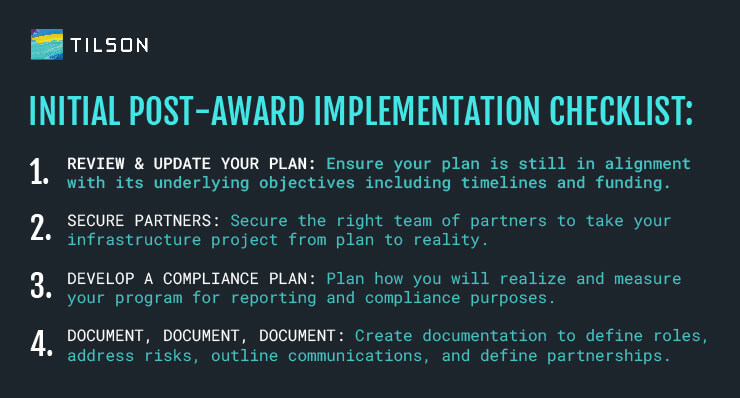Throughout this series of articles, we have discussed the planning activities that build the foundation for a strong application for broadband infrastructure funding. We have discussed:
In this fifth and final article, we will explore the initial implementation steps to take after you are awarded funding for your project.
First, take a moment to celebrate a major milestone! It requires some serious effort to develop your project, define its objectives, quantify its impact, and understand potential risks and challenges. That work has now translated into a win and your application has been funded. This is a major achievement; now, it is time to roll up your sleeves and put the term “shovel-ready” to the test!
Now that the champagne has been consumed, let’s shift to the first action item – reviewing and updating your plan to ensure it is still in alignment with its underlying objectives. Funding opportunities have differing timelines, and there may exist a gap in time between initial planning efforts and official award of subsidization. So, it is important to review key assumptions and the current environment of your project, making any necessary adjustments.
One major factor to consider as you undertake this review/adjustment is the level of funding that you have been awarded. It is possible that you could have received less funding than originally requested. Some questions you may need to consider:
From our high-level design process, we should have a strong idea of cost, both capital and operational, and where funds should be prioritized. Perhaps there is potential for project modification to reduce costs and project scope to align with available funding.
Assuming we have successfully re-aligned the project with the available funding, we need to work through strategic vendor selection. The right team of partners is critical to push projects through implementation. While this could mean many things depending on the underlying project, the process typically involves using your project plan as a guide to draft one or more RFPs that will attract competent vendors to execute your vision. In some cases, the partners that you worked with to develop an application will be natural implementation partners; in other cases, additional expertise will be needed. Drafting a robust RFP, marketing the RFP to the right parties, thoroughly evaluating responses, and engaging in vendor negotiations is a substantial task. However, it is of great importance to secure the right team take your infrastructure project from plan to reality.
If you don’t yet have a strong partner to plan, build, and maintain your broadband network, contact us to discuss your specific connectivity goals.
While some legwork has been done to understand post-award compliance when evaluating funding opportunities, now that we have officially secured an award it is imperative that a compliance plan is developed. This plan will ensure all stakeholders and vendors have full visibility into the oversight requirements of the funder. The guiding document for compliance requirements is typically a Grant Disbursement Agreement (GDA) – this document will outline all the strings that are attached to the funding. Usually, this document must be executed as part of an award for funding. Compliance requirements vary substantially, based on funding sources. Reporting and audits may occur mid- or post- project execution (or both), and requirements may carry forward for substantial periods of time following implementation. Depending on your vendor(s) and their experience, they may be a valuable source of guidance in developing compliance protocols.
Finally, it’s time to kick things off officially, pulling all stakeholders and vendors together to define roles, solidify anticipated timelines, and coordinate milestone touchpoints to keep the project on track. We recommend that you develop strong documentation in this phase. Every “partnership” can be boiled down to an agreement to consume or deliver things like products, services, funding, or ownership. Thus, each relationship should be codified in a contract. When large teams with numerous vendors or stakeholders are in play, it is important to document responsibilities and accountability. A Division of Responsibility (DOR) matrix, which describes the RACI (Responsible, Accountable, Consulted, and Informed) assignment of each party is an extremely helpful governing document, in these situations. Similarly, a project Risk Register – describing known risks, their potential impact, and planned mitigation strategies – can also ensure that project team members are organized and aligned. Finally, a project communications plan that aligns with the DOR and Risk Register is a great tool to ensure that stakeholders are informed and consulted, as previously agreed.
Every entity applying for and obtaining financial subsidy has a unique posture and differing challenges. With proper planning and thoughtful execution, these challenges can be defined, addressed, and surmounted. This series of articles was designed to offer a broad overview of the activities necessary to develop strong, “shovel-ready”, applications for funding, while providing high-level guidance to encourage impactful projects to be successful. At Tilson, we are familiar with the entire lifecycle of broadband infrastructure project implementation from conception to reality and leverage our experience to provide first in class service to our clients. Contact us today to discuss your project in more detail with our expert team.


Adam Quinlan serves as Manager of Broadband Consulting at Tilson, leading a team of experienced consultants to plan, design, build, and maintain viable and cost-effective broadband solutions. Adam joined Tilson in 2016, with a strong technical background and leadership experience as a managing partner of a small law firm focused on the intersection of law and technology. He holds a Bachelor’s degree in Economics, a Juris Doctor from the University of Maine School of Law, and is a licensed member of the Maine and Massachusetts Bar.